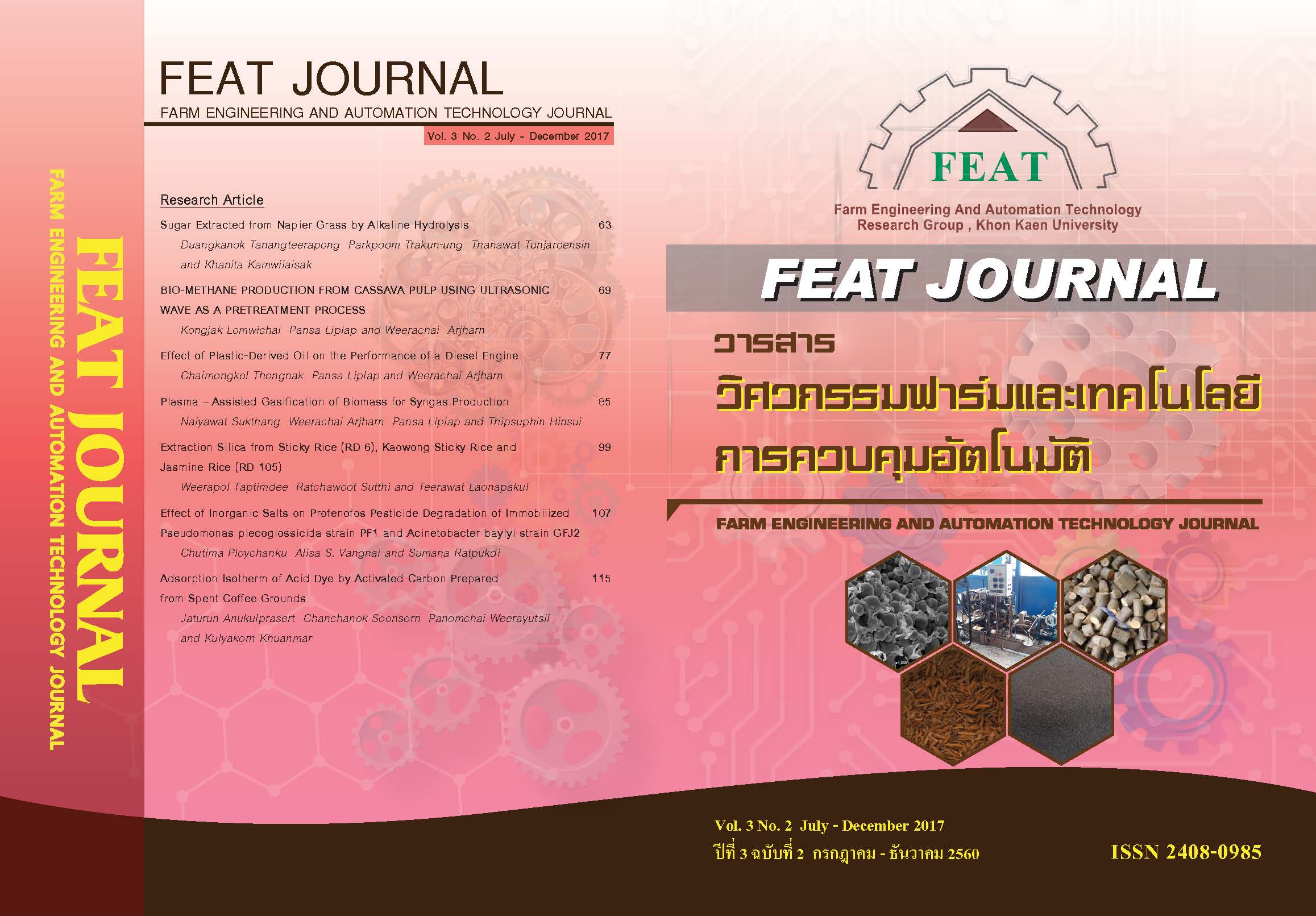ผลกระทบของเกลืออนินทรีย์ต่อการย่อยสลายสารกำจัดศัตรูพืชโพรฟีโนฟอส ด้วยจุลินทรีย์สายพันธุ์ Pseudomonas plecoglossicida strain PF1 และ Acinetobacter baylyi strain GFJ2 ในรูปแบบเซลล์ตรึง
Main Article Content
บทคัดย่อ
โพรฟีโนฟอสเป็นสารกำจัดศัตรูพืชในกลุ่มออร์แกโนฟอสเฟตที่ได้รับถูกใช้อย่างแพร่หลายซึ่งทำให้มีโอกาสตรวจพบการปนเปื้อนในสิ่งแวดล้อมในปริมาณที่สูง การย่อยสลายโฟรพีโนฟอสด้วยวิธีทางชีวภาพภายในพื้นที่นั้นต้องอาศัยสภาวะที่เหมาะสมต่อการทำงานของจุลินทรีย์ในสิ่งแวดล้อม ซึ่งเทคโนโลยีการตรึงเซลล์นั้นช่วยปรับปรุงการทำงานของจุลินทรีย์ได้ ดังนั้นในงานวิจัยนี้จึงได้มีการศึกษาผลกระทบของเกลืออนินทรีย์ที่ปนเปื้อนในสิ่งแวดล้อมที่มีผลต่อการย่อยสลายสารโพรฟีโนฟอส โดยจุลินทรีย์สายพันธุ์ Pseudomonas plecoglossicida strain PF1 (PF1) และ Acinetobacter baylyi strain GFJ2 (GFJ2) ในรูปแบบเซลล์ตรึง การศึกษานี้เลือกสารแคลเซียมแอลจิเนตเป็นวัสดุตรึง ส่วนเกลืออนินทรีย์ที่ศึกษา ได้แก่ โซเดียมคลอไรด์ แมกนีเซียมซัลเฟต และแคลเซียมคาร์บอเนต ที่ความเข้มข้น 0-1,000 มิลลิกรัมต่อลิตร จากผลการทดลองปรากฏว่าเซลล์ตรึงทั้ง 2 ชนิดสามารถย่อยสลายสารโพรฟีโนฟอสได้ดีกว่าเซลล์อิสระโดยมีประสิทธิภาพการย่อยสลายจาก 40-70% เป็น 50-90% ส่วนการทดลองการย่อยสลายสารโพรฟีโนฟอสของเซลล์ตรึงทั้งสองชนิดหลังจากที่มีการเติมเกลืออนินทรีย์ พบว่าเกลือมีส่วนทำให้ประสิทธิภาพการย่อยสลายนั้นลดลงในทุกการทดลอง
Article Details
วารสารวิศวกรรมฟาร์มและเทคโนโลยีควบคุมอัตโนมัติ (FEAT Journal) มีกําหนดออกเป็นราย 6 เดือน คือ มกราคม - มิถุนายน และกรกฎาคม - ธันวาคม ของทุกปี จัดพิมพ์โดยกลุ่มวิจัยวิศวกรรมฟาร์มและเทคโนโลยีควบคุมอัตโนมัติ คณะวิศวกรรมศาสตร์มหาวิทยาลัยขอนแก่น เพื่อเป็นการส่งเสริมและเผยแพร่ความรู้ ผลงานทางวิชาการ งานวิจัยทางด้านวิศวกรรมศาสตร์และเทคโนโลยีพร้อมทั้งยังจัดส่ง เผยแพร่ตามสถาบันการศึกษาต่างๆ ในประเทศด้วย บทความที่ตีพิมพ์ลงในวารสาร FEAT ทุกบทความนั้นจะต้องผ่านความเห็นชอบจากผู้ทรงคุณวุฒิในสาขาที่เกี่ยวข้องและสงวนสิทธิ์ ตาม พ.ร.บ. ลิขสิทธิ์ พ.ศ. 2535
References
[2] Harnpicharnchai K., Chaiear N., & Charerntanyarak L. (2013). Residues of organophosphate pesticides used in vegetable cultivation in ambient air, surface water and soil in Bueng Niam subdistrict, Khon Kaen, Thailand. Southeast Asian Journal of Tropical Medicine and Public Health, 44(6), 1088-1097.
[3] Sapbamrer R., & Hongsibsong S. (2014). Organophosphorus pesticide residues in vegetables from farms, markets, and a supermarket around Kwan Phayao Lake of Northern Thailand. Archives of Environmental Contamination and Toxicology, 67(1), 60-67.
[4] Santos da Silva S., Chiavone-Filho O., de Barros Neto E. L., Foletto E. L., & Mota A. L. N. (2013). Effect of Inorganic Salt Mixtures on Phenol Mineralization by Photo-Fenton-Analysis via an Experimental Design. Water, Air, & Soil Pollution, 225(1), 1-10.
[5] Karpouzas D. G., & Walker A. (2000). Factors influencing the ability of Pseudomonas putida strains epI and II to degrade the organophosphate ethoprophos. Journal of Applied Microbiology, 89(1), 40-48.
[6] Siripattanakul-Ratpukdi S., Vangnai A. S., Sangthean P., & Singkibut S. (2014). Profenofos insecticide degradation by novel microbial consortium and isolates enriched from contaminated chili farm soil. Environmental Science and Pollution Research, 22(1), 320-328.
[7] Siripattanakul S., & Khan E. (2010). undamentals and applications of entrapped cell bioaugmentation for contaminant removal Emerging Environmental Technologies (Vol. 2, pp. 147-169): Springer Netherlands.
[8] Hongsawat P., & Vangnai A. S. (2011). Biodegradation pathways of chloroanilines by Acinetobacter baylyi strain GFJ2. Journal of Hazardous Materials, 186(2–3), 1300-
1307.
[9] Chandrasekar N., Selvakumar S., Srinivas Y., John Wilson J. S., Simon Pete, T., & Magesh N. S. (2014). Hydrogeochemical assessment of groundwater quality along the coastal aquifers of southern Tamil Nadu, India. Environmental Earth Sciences, 71(11), 4739-4750.
[10] Chung S. Y., Venkatramanan S., Kim T. H., Kim D. S., & Ramkumar T. (2015). Influence of hydrogeochemical processes and assessment of suitability for groundwater
uses in Busan City, Korea. Environment, Development and Sustainability, 17(3), 423-441.
[11] Singaraja C., Chidambaram S., Anandhan P., Prasanna M. V., Thivya C., & Thilagavathi R. (2015). A study on the status of saltwater intrusion in the coastal hard rock aquifer of South India. Environment, Development and Sustainability, 17(3), 443-475.
[12] Ebrahimi S., Nguyen T. H., & Roberts D. J. (2015). Effect of temperature & salt concentration on salt tolerant nitrate-perchlorate reducing bacteria: Nitrate degradation kinetics. Water Research, 83, 345-353.

